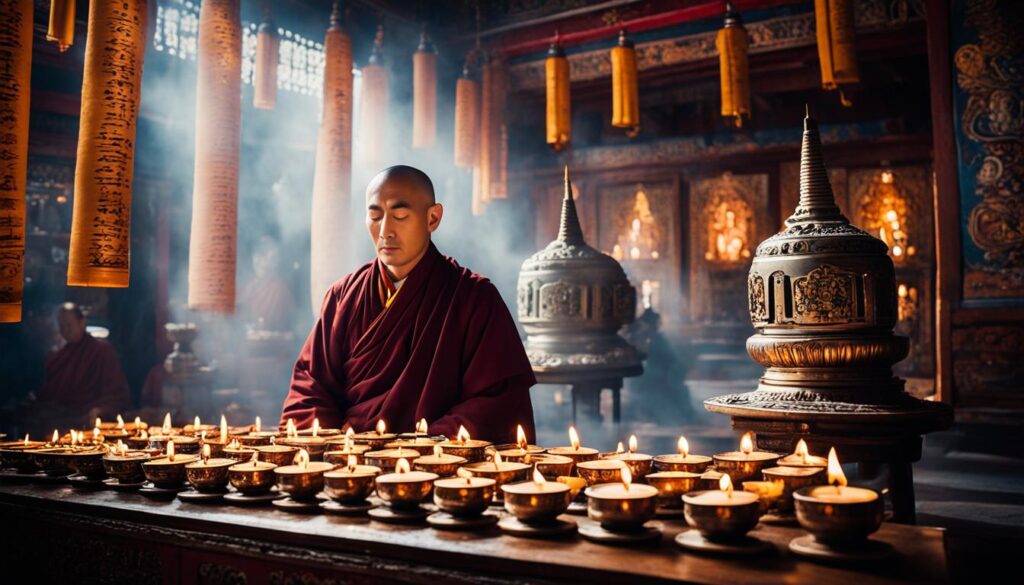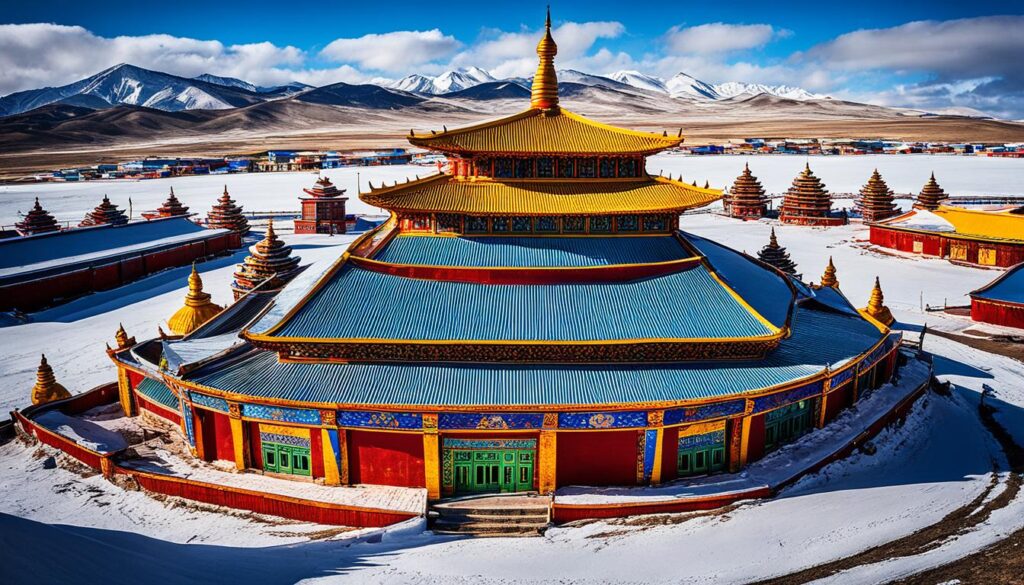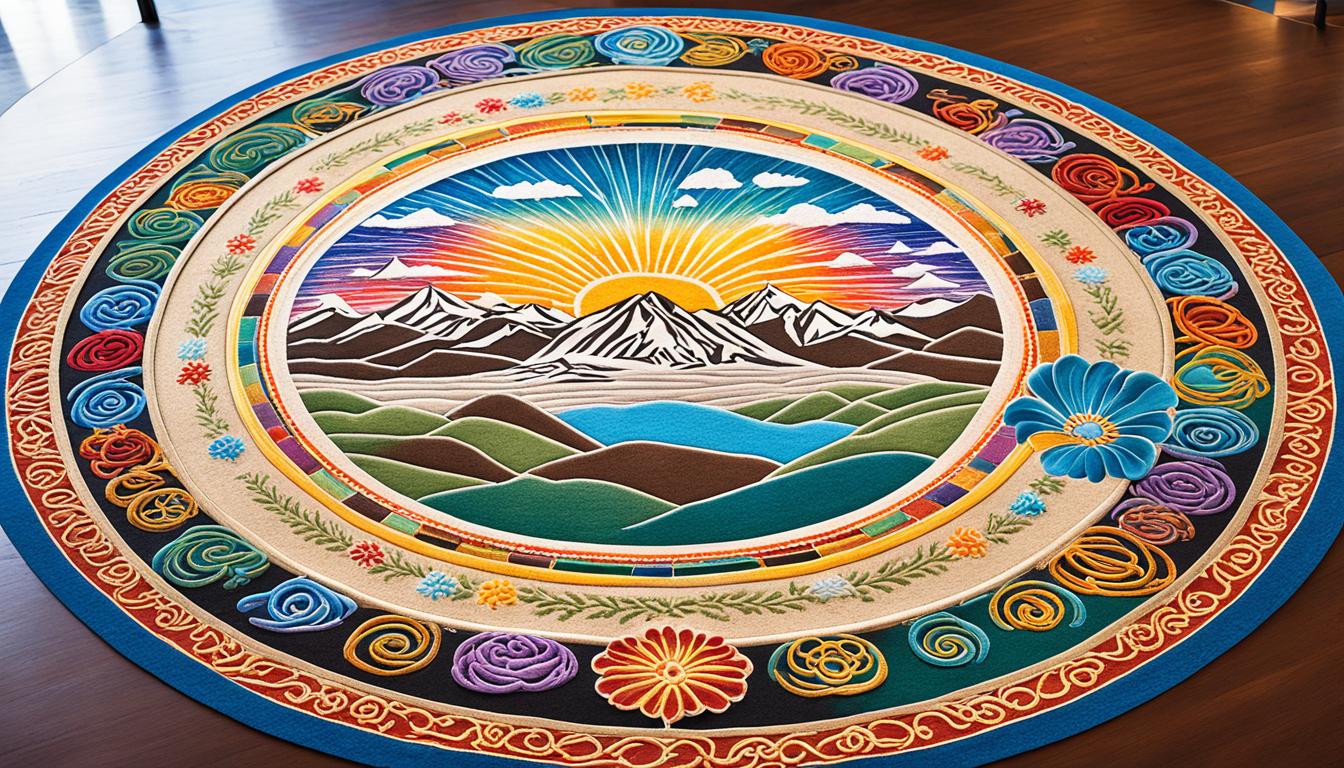Have you ever wondered about the profound spiritual traditions of Mongolia? Delve into the fascinating world of Mongolian Buddhism, also known as Mongolian lamaism, and discover the unique blend of ancient wisdom and modern relevance that it offers.
Despite its remote location, Mongolia is home to a vibrant Buddhist community, with Buddhism being the largest religion practiced by over half of its population. Steeped in history and deeply rooted in Mongolian culture, this spiritual tradition holds many secrets waiting to be unveiled.
From the rich history and practices of Mongolian Buddhism to its influential role in society, explore the profound teachings that have guided generations towards mindfulness, compassion, and personal growth.
Key Takeaways:
- Mongolian Buddhism, also known as Mongolian lamaism, is the largest religion in Mongolia, practiced by over half of the country’s population.
- It has deep roots in Mongolian culture and history, deriving many of its characteristics from Tibetan Buddhism.
- Mongolian Buddhism has its own set of unique practices, including generation stage, completion stage, and tantric techniques such as mandala, mantra, and mudra.
- Buddhist art in Mongolia is intricate and captivating, showcasing the teachings and stories of Buddhism.
- Mongolian Buddhism has had a significant impact on society, fostering mindfulness, compassion, and ethical conduct.
The Rich History and Practices of Mongolian Buddhism
Buddhism in Mongolia has a rich historical background and encompasses a variety of spiritual practices that have evolved over the centuries. Understanding the history and exploring the diverse practices of Mongolian Buddhism provides valuable insights into the cultural and spiritual heritage of this ancient tradition.
The journey of Buddhism in Mongolia began during the Yuan dynasty, when the Mongols adopted Tibetan Buddhism as their primary religious belief. This marked the first significant encounter between Mongolian culture and Buddhism, creating a foundation for the growth and development of the religion within the region.
However, following the collapse of the Mongol Empire, the practice of Buddhism experienced a decline, and it wasn’t until the 16th and 17th centuries that it resurged in Mongolia. During this period, the conversion to Buddhism was predominantly limited to the nobility and ruling families, resulting in the establishment of numerous monasteries throughout the country.
One of the major contributions of the Mongols to Buddhism was the introduction of Tibetan Buddhist monasticism. This influence led to the establishment of monastic communities, with monks and nuns playing vital roles in propagating Buddhist teachings and preserving the spiritual practices of Mongolian Buddhism.
Mongolian Buddhism has its own distinct set of practices and rituals that have evolved over time. These practices encompass various stages, including the generation stage, completion stage, and tantric techniques such as mandala, mantra, and mudra.
The generation stage involves the visualization of deities and Buddhas to cultivate compassion, wisdom, and spiritual transformation. On the other hand, the completion stage focuses on advanced meditation practices that aim to achieve enlightenment and transcendence through various yogic exercises.
Tantric techniques, such as the use of mandalas, mantras, and mudras, form an integral part of Mongolian Buddhist practices. Mandalas are intricate symbolic diagrams used for meditation and visualizations, while mantras are sacred chants that harness the power of sound for spiritual awakening. Mudras, hand gestures, are employed to channel and direct energy during meditation and ritual ceremonies.
By immersing yourself in the rich history and practices of Mongolian Buddhism, you can gain a deeper appreciation for this profound spiritual tradition and discover the transformative power it holds for individuals seeking enlightenment and inner peace.

Mongolian Buddhist Art and Temples
Mongolian Buddhism is not just a spiritual practice but also a rich tradition of art and architecture. The Mongolian Buddhist temples are architectural wonders that showcase the religious and cultural significance of Buddhism in Mongolia. These temples serve as sanctuaries for devotion, meditation, and learning.
One of the most notable Buddhist temples in Mongolia is the Erdene Zuu Monastery in Karakorum. Built in the 16th century, it is a symbol of Mongolian Buddhist heritage. The monastery complex consists of multiple temples, stupas, and a defensive wall. It harmoniously blends Mongolian, Tibetan, and Chinese architectural styles, creating a unique and captivating atmosphere of spirituality.
Inside the Mongolian Buddhist temples, visitors can witness a breathtaking display of Buddhist art. Thangka paintings, with their intricate details and vibrant colors, decorate the walls, depicting the life of Buddha, Bodhisattvas, and scenes from Buddhist scriptures. These magnificent artworks serve as visual aids for meditation and contemplation, inspiring devotion and enlightenment.
The temples also house statues of Buddha and Bodhisattvas, capturing the essence of compassion, wisdom, and enlightenment. These statues, often adorned with gold leaf and precious gemstones, are revered as objects of worship and serve as reminders of the Buddhist values and principles.
Another form of artistic expression in Mongolian Buddhism is the creation of elaborate mandalas. Mandalas are symbolic representations of the universe and serve as tools for meditation and spiritual transformation. They are meticulously created using colored sand, grains, or other materials, and then carefully dismantled to emphasize the impermanence of all things.
The Spiritual Beauty of Mongolian Buddhist Art
The beauty of Mongolian Buddhist art lies not only in its visual aesthetic but also in its spiritual symbolism. Each stroke of the brush, each embellishment on the statues, and each grain of sand in the mandalas carries deep spiritual meaning and serves as a reminder of the interconnectedness of all beings.
The intricate thangka paintings, for example, serve as visual narratives of Buddhist teachings, allowing practitioners and viewers to immerse themselves in the wisdom and compassion of the Buddha’s teachings. Through these paintings, one can gain insights into the nature of suffering, the path to liberation, and the interconnectedness of all phenomena.
The statues of Buddha and Bodhisattvas, on the other hand, embody the qualities of enlightenment and serve as a source of inspiration and guidance. They remind us of the potential for awakening that resides within each individual and invite us to cultivate compassion, wisdom, and mindfulness in our own lives.
The creation of mandalas is a profound spiritual practice in itself. It requires meticulous attention to detail and a deep understanding of the cosmic order. As practitioners participate in the creation of mandalas, they engage in a meditative process that helps cultivate focus, patience, and a sense of interconnectedness.
| Art Forms in Mongolian Buddhism | Description |
|---|---|
| Thangka Paintings | Intricate paintings depicting Buddhist teachings and stories |
| Statues of Buddha and Bodhisattvas | Representations of enlightenment and embodiments of compassion |
| Mandalas | Sacred geometric designs depicting the cosmos and serving as objects of meditation |
If you ever have the opportunity to visit Mongolia, make sure to explore the mesmerizing Mongolian Buddhist temples and immerse yourself in the spiritual beauty of the art. It is an experience that will leave a lasting impression and nourish your soul.

The Influence of Mongolian Buddhism in Society
Mongolian Buddhism has had a significant impact on society, promoting values such as mindfulness, compassion, and ethical conduct. Buddhist leaders, known as Khalkha lamas, have played important roles in guiding the Mongolian people and addressing modern challenges. The teachings of Buddhism offer insights into personal and societal harmony, providing guidance for individuals and communities to navigate the complexities of the modern world.

Khalkha lamas, as spiritual leaders, hold a revered position in Mongolian society. They are respected for their wisdom, compassion, and ability to offer guidance in both spiritual and practical matters. As custodians of Buddhist teachings, they provide moral support, spiritual guidance, and advice to individuals seeking a deeper understanding of themselves and their place in the world.
Mongolian Buddhism’s impact extends beyond the individual level, influencing societal norms and values. The emphasis on mindfulness cultivates a sense of awareness and presence, leading to more compassionate and ethical interactions. This focus on compassion promotes a sense of community and interconnectedness, inspiring individuals to contribute to the well-being of society as a whole.
Addressing modern challenges is another crucial aspect of Mongolian Buddhism’s influence. The teachings emphasize the importance of adaptability and resilience in the face of change. Buddhism encourages followers to develop the qualities necessary to address the social, environmental, and economic challenges of the modern world.
Mongolian Buddhism’s positive impact on society is evident in various aspects of daily life. From promoting kindness and compassion in personal relationships to fostering a sense of responsibility towards the environment, Buddhism’s principles guide individuals and communities in creating a harmonious and sustainable society.
Conclusion
Mongolian Buddhism, with its rich spiritual heritage, offers invaluable insights and enlightening practices for personal growth, societal harmony, and navigating the challenges of the modern world. By embracing the spirit of Mongolian Buddhism, you can tap into the deep wisdom of this tradition and cultivate inner peace, compassion, and a profound understanding of both yourself and the world around you.
The teachings of Mongolian Buddhism guide individuals on a path towards self-discovery and transformation. Through practices such as meditation, mindfulness, and the cultivation of ethical conduct, you can embark on a journey of self-reflection, leading to greater self-awareness and personal enlightenment.
Furthermore, Mongolian Buddhism emphasizes the importance of interconnectedness and compassion towards all sentient beings. By embracing these values, you not only benefit yourself but also contribute to creating a more harmonious and compassionate society. The spiritual practices of Mongolian Buddhism enable individuals to develop a sense of empathy, kindness, and reverence for all life.
In conclusion, the spirituality and teachings of Mongolian Buddhism serve as a beacon of wisdom and inspiration in today’s fast-paced and often challenging world. Through its enlightening practices, Mongolian Buddhism offers a transformative experience, enabling individuals to uncover their true potential and embrace a more fulfilling and purposeful life.
FAQ
What is Mongolian Buddhism?
Mongolian Buddhism is a form of Tibetan Buddhism that is practiced in Mongolia. It has deep roots in Mongolian culture and history, and promotes mindfulness, compassion, and personal and societal harmony.
How did Buddhism first come to Mongolia?
Buddhism first came to Mongolia during the Yuan dynasty when the Mongols adopted Tibetan Buddhism. However, its practice declined after the collapse of the Mongol Empire and reemerged in the 16th and 17th centuries.
Who converted to Buddhism in Mongolia?
The conversion to Buddhism was primarily limited to the nobility and ruling families in Mongolia. This led to the establishment of many monasteries and the introduction of Tibetan Buddhist monasticism.
What are some unique practices in Mongolian Buddhism?
Mongolian Buddhism has its own set of practices, including generation stage, completion stage, and tantric techniques such as mandala, mantra, and mudra.
What is the significance of Mongolian Buddhist art and temples?
Mongolian Buddhist art includes intricate thangka paintings, statues of Buddha and Bodhisattvas, and elaborate mandalas. The temples, like the Erdene Zuu Monastery in Karakorum, showcase the religious and cultural importance of Buddhism in Mongolia.
How has Mongolian Buddhism influenced society?
Buddhist leaders known as Khalkha lamas have played important roles in guiding the Mongolian people and addressing modern challenges. The teachings of Buddhism promote values such as mindfulness, compassion, and ethical conduct.
What insights can be gained from Mongolian Buddhism?
The teachings and practices of Mongolian Buddhism offer valuable insights for personal growth, societal harmony, and addressing contemporary challenges. By embracing the spirit of Mongolian Buddhism, individuals can cultivate inner peace, compassion, and a deeper understanding of themselves and the world around them.

